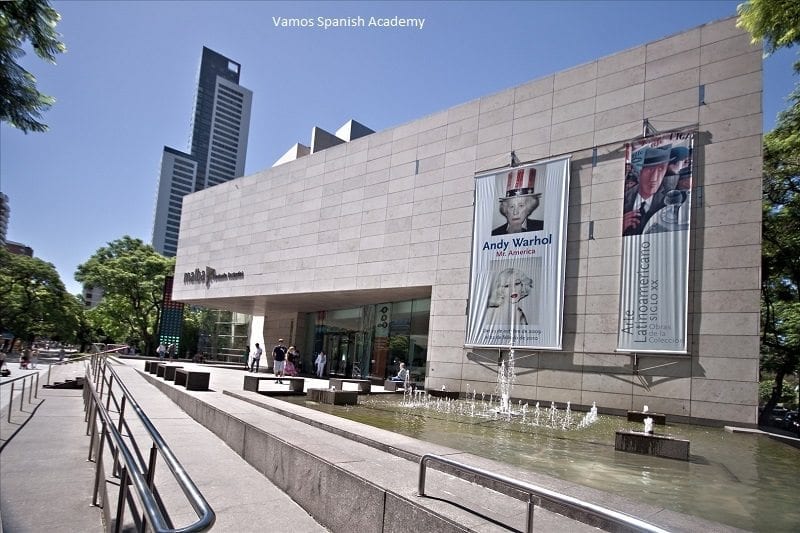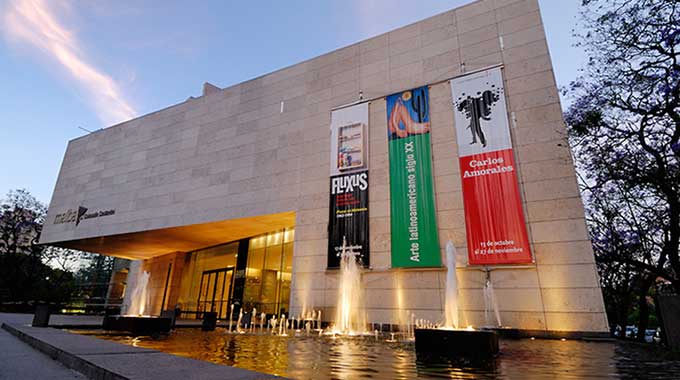Malba Buenos Aires
MALBA is the museum of modern Latin-American art located in the center of the city. It is the most visited Museum in Buenos Aires and renowned throughout Latin-America as one of the best museums. While I am generally reticent about going to museums in large cities because I can get bored with them (very quickly), MALBA was the first museum that I can honestly say I was excited to see all the way through from beginning to end (both of the times that I went..).
History of MALBA
MALBA was constructed in September of 2001 during a harsh economic downturn in Argentina. Despite the economic limitations, the government decided to build MALBA to foster the development and acknowledgment of Latin-American art from the beginning of the 20th century onwards. Furthermore, it was intended to educate locals and visitors about the dynamic and ever evolving culture, history, and diversity that shapes Latin-America. Since its inauguration, the museum has received exceptional reviews and become well-known throughout the world as a paragon for modern art museums.
Malba Architecture
The building itself is a spectacle. Modern and bold, you can tell that it is a museum of contemporary art solely based off of its appearance. Despite the impressiveness of the architecture, the building doesn’t distract the visitors and upstage the art inside. Huge stark white walls and simple decorations make all of the artwork stand out. Likewise, there is just enough segmentation of the rooms and architectural dissimilarity so that you don’t feel like you’re looking at art inside of a blank and empty warehouse.

Malba Permanent Collection
More importantly than the architecture, the art within the MALBA is some of the most avant-garde and revolutionary modern art in the world. There is a permanent collection of Antonio Berni, Diego Rivera, Juan Gris, Frida Khalo, Ernesto Deira, Xul Solar, Guillermo Kuitca etc on display. Many of these artists travelled to countries in Europe at the onset of the 20th century where they were influenced by avant-garde movements such as Expressionism, Cubism, and Futurism. During the twenties these artists returned to their home countries in Latin-America and started movements that would redefine Latin-American art. During this time period Neocriolism was started in Buenos Aires, Anthropophagia in Sao Paulo, and Vibrationism and Constructive Universalism in Montevideo to name a few of the more influential ones. The permanent collection in MALBA illustrates these movements and gives the viewer a glimpse into the economic, political, and social transformations that transpired and continue today throughout Latin-America.
Malba Temporary Exhibits
The art that is always displayed in MALBA is worth the visit within itself, but the temporary exhibits that are constantly being changed are what make MALBA truly unique. They change drastically and frequently, perhaps a metaphor for many of the countries in Latin-American. I have been twice, and each time was so distinct from one another that it felt like I had been to two different museums in two different countries. The first time was a collection of Berni. The exhibit told the stories of Juanito and Ramona. Juanitos life symbolized what many people experienced when they moved to Buenos Aires in the 19th and early 20th centuries; people that migrated here in search of a better life but struggled to find it yet remained hopeful. Ramona, on the other hand, finds a way to integrate into the lives of the social and political elite through a life of prostitution. Berni displayed their lives through a large collection of work devoted to each story that was clear based off of the way MALBA organized the exhibit.
The second time I went there was no art on any of the walls but instead a strange interactive exhibit on the top floor. The first room was completely white and people were rolling paint on the walls. At first I thought that we had come at an unfortunate interim period. It then struck me that it was intentional and it was the first part of the exhibit. It was already so different from the first time I had visited the museum I was eager to discover what would happen in the next room. I cannot accurately describe what was displayed in the proceeding rooms so I won’t even attempt to explain them. All I will say is that we felt a strange combination of discomfort and intrigue that was just as repulsive as it was tantalizing (not to mention an altered state of mind that felt drug induced). Perhaps that is what modern art is intended to evoke.
Conclusion
You will definitely see and react to all of the art in MALBA in a unique manner and it is something you need to see for yourself. Regardless of how it appeals to you, it is a museum that you must experience in Buenos Aires. Hopefully your trip to the museum will help you understand what life is like in Latin-America and give you some insight into the complexities that make Buenos Aires so intriguing.
Warning
The exhibit we went to was incredibly strange and made us all feel like we had consumed drugs prior to going. Thus, if you decide to go in an influenced mind things could get very weird depending on the exhibit they are showcasing. Also there is some art that simply makes no sense – whatsoever and may infuriate you.
Note
Wednesdays are discount days, general admission only costs 60 pesos. Also, if you have some sort of student card it is free. Tuesdays closed.
For more information about our Spanish School in Argentina come visit us at Viamonte 1516, Buenos Aires.






